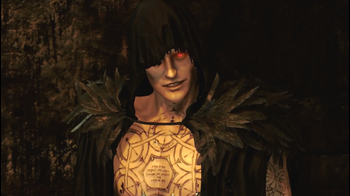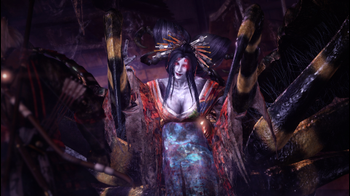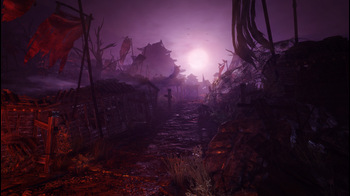
Nioh Review
Nioh takes direct inspiration from the Souls series - there's no doubt about that. While other titles have tried their best to emulate those games, this one builds upon that foundation and creates an experience that is virtually unmatched. While Souls can at times feel slow and plodding, Nioh cranks the energy level to the breaking point while delivering an absurd supply of content to keep you busy.
The story takes place during the late Sengoku era of Japan in the 1600s. The Queen of England is hell bent on obtaining the fabled Philosopher's Stone to the point that she goes to war with Spain in order to procure it. But there's something even more malevolent happening.
The Irish sailor William Adams awakens to find himself confined in a jail cell with only a pair of trousers on. A lone guard makes his rounds, pacing ever so slowly back and forth beyond his door. Suddenly, a spirit appears and helps him escape through a crumbling wall. He soon discovers his first weapon, a bastard sword, and proceeds to escape from the giant stone fortress he finds himself in.
During his escape, he overhears two soldiers discussing a plot by the British government to influence the civil war between the Tokugawa and Ishida clans of Japan in order to obtain the mystical Amrita.
This precious source of energy is said to grant an immense level of power to those who weld it. Because William found out about their collusion, he was imprisoned. What they don't know is that an occultist by the name of Edward Kelley looks to manipulate both sides from the shadows.
Nioh's historical retelling of the Sengoku era of Japan is downright brilliant. You'll meet some of the key figures from that period including Tokugawa Ieyasu and Hanzo Hattori, each of them playing their own important role throughout William's journey. While the story isn't always coherent, especially during transitional cutscenes, any qualms I have with the plot are corrected through its picturesque setting and atmosphere.
The way Nioh contextualizes every single gameplay element lends a lot of credence to the world it is attempting to build. From asking for your preferred weapon type to the armor you carry around, it is clear that the developers spent a huge chunk of time focusing on the quality of the flavor text. I couldn’t help but spend some time getting to know the lore of the game, absorbing as much of it as I possibly could.
The combat in the game is incredibly exciting. There are five different weapon types to choose from - katana, dual katana, spear, axe, and the kusarigama (a blade on a chain you swing around). Every weapon has a low stance, mid stance, and high stance; each stance modifies the supply of attack power and Ki (stamina) consumed. There are also three kinds of long range weapons: bows, rifles, and hand cannons - the latter of which is very fun to use in groups of enemies.
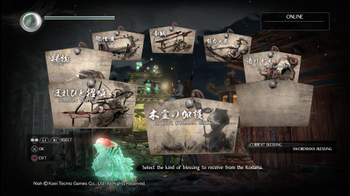
Suffice to say, there's a large volume of depth to indulge in, and you won't be able to survive by simply mashing buttons. It's crucial to master the benefits of each stance to make the most of every confrontation. With all of the different weapons, armor, and accessories available, there is an insane measure of equipment to obtain that are all color coded according to its rarity. So, if you're as addicted to those types of games as I am, you'll be very happy.
Managing your Ki bar is key. Once you deplete this stamina bar, you'll be left exhausted and vulnerable to oncoming attacks. Therefore, mastering the Ki Pulse technique is crucial to your success. As you swing your weapon, these small blue orbs start to gather around your body. By hitting R1, you're able to immediately regain the Ki you spent and speeds up stamina recovery. This takes some getting used to, but once you get the hang of how combos work, it feels immensely satisfying being able to dispatch a foe in moments.
Through continually using your weapons or techniques, you increase your proficiency towards them which grants skill points. Once maximum familiarity with a piece of equipment has been reached, its traits can be passed on to other equipment if you decide to dismantle them. Only one of these special effects can be inherited,
Skill points can be used towards increasing the length of your combo along with latent benefits, such as performing a Ki Pulse every time you dodge roll or grabbing a weapon when you're bare-handed. There is also Onmyo magic that grant elemental powers to your weapons, and Ninja skills which lets you craft different tools like kunai and shuriken.
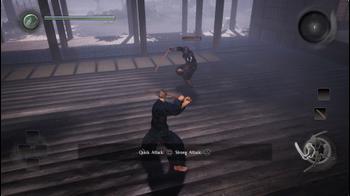
There are plenty of skills to unlock, so be prepared to spend some time understanding how the skill tree works. If you do mess up, there is an item that lets you reset your stats and skill points so you can respec. I found myself doing this a couple of times when I wasn't happy with a boss encounter, so it's a very welcome feature.
Newcomers will appreciate the inclusion of a comprehensive tutorial dojo. It goes through all of the important gameplay functions of the game, both in and out of combat. The only downside is that the game introduces these tutorials over the span of a few missions. Unless you’re the type of person to catch on to the controls rather quickly, you’ll have to wait a little while to fully understand what you’re doing. Otherwise, the tutorial dojo is a very welcome addition and has grown in breadth ever since Koei Tecmo decided to include it in the Nioh beta onwards.
Another feature is the Guardian Spirit. Each guardian spirit is imbued with its own stat bonuses and rate increases. Its most important function is the Living Weapon. Once the Amrita gauge on the top left of the screen is full, you can unleash their unique special ability that lasts for a period of time. Living Weapon causes you to become invincible to any damage while increasing your close combat damage.
The gauge will deplete over time with every attack you or the enemy lands, and once the gauge is depleted, the effect goes away. There are ways to extend the amount of time Living Weapon is active, and this can become absolutely devastating during every single boss fight in the game.
The guardian spirit also plays another vital role - banking all the Amrita you have collected. If you happen to die in battle, the guardian spirit will remain where your body fell until you're able to rescue it. If you die again before reaching the spirit, you lose all the Amrita on your person. Think of it like a corpse run, but you aren't put into a weakened state while in limbo. You can also summon the guardian spirits back using a shrine at the cost of Amrita.
While the gameplay is challenging, it never felt unforgiving. It was never the game’s fault I died - I was the one who got ambushed or rolled off a cliff or hit the wrong button when panicking.
When things do come together after hours of confronting a difficult boss, there is this tremendous satisfaction that can’t be measured. Yes, you'll die - a lot - but I didn't feel beaten down like I did in Dark Souls. I credit that in part to the nice, calming music that plays every time I died, motivating me to push forward and try yet again. And while the boss battles can be obtuse, once you figure out their patterns and have built an optimal character, it comes done to practicing patience in order to defeat them.
One of the new features introduced in the final game that wasn't in the demos is the Prestige system. Think of it like an in-game achievement system. By completing certain objectives, like defeating 50 humans with a spear, you're able to earn prestige points. This can be used towards different passive abilities which may take the form of increasing resistance against status effects, boosting your Onmyo magic power, or raising the chance of discovering rare items. The bonuses are also randomized - as soon as you spend a point on a benefit, another one takes its place. It's a great incentive towards playing strategically.
Once you have completed a mission, the "Twilight" version of that level becomes available. Twilight missions provide a higher degree of difficulty in return for greater rewards including rare equipment. There are also side missions which approaches the available levels in different ways; you may face the spirit of a legendary samurai one-on-one in a wheat field on a map you played earlier but set during the daytime.
This offers a nice dose of replayability to the game alongside its Cooperative mode. This allows you to go through all of the Nioh's missions with a friend. You can also randomly join a player's game if they're asking for help. Playing with others led to some pretty amazing moments that I wouldn't be able to witness on my own - having an extra person around creates a whole new teamwork dynamic.
The game also features a Clan Battles system. By performing different actions, you earn points towards your chosen clan. In return, it provides you stat and skill bonuses, along with new costumes and gestures.
I didn't experience any network connectivity issues when the servers went live last week, but we'll have to see if that holds up when the game releases.
There's something outstanding about the scenery in Nioh. The world feels meticulously hand-crafted, with a nice level of detail going into every little corner of the modeled environments. The lighting and weather effects are also a real treat for the eyes.
Granted, some of the surroundings look drab up-close, and it can't compare to the gothic designs in Bloodborne, but the outdoor areas more than make up for that.
To me, Team Ninja has always had very impressive art direction in their titles and Nioh is no exception. The breathtaking vistas are a sight to behold, backed by an excellent musical score and terrific voice acting, both in English and Japanese, that never broke my immersion.
Not only is it visually remarkable, but the game is technically sound. Despite the size of the maps and the different AI it needs to generate, load times are practically nonexistent even on a base PlayStation 4 - something I’m sure Souls fans will take notice of. I found myself getting surprised at how quickly I was able to launch right back into a game between levels or deaths.
Nioh also has a unique feature that lets you switch between an “action mode”, which locks the framerate at 60FPS with an adaptive resolution, to a “movie mode” that puts the framerate at 30FPS but improves the visuals. PlayStation 4 Pro owners get the added benefit of a “variable mode” that delivers the best possible results of both options. I did not experienced any hiccups or slowdown with the action or movie modes, though I have heard of some unevenness with the variable mode.
Complimented by the large scale of customization and Twilight missions, there is a lot take in here. Nioh loves to rewards its players, and will do everything in its power to keep your full attention, cheering you on even when it's being uncompromising. And when you've beaten the game, the New Game + mode is there there for you, adding new items, equipment, and the ability to change the look of William Adams.
Nioh creates its own distinct persona with ingenious game design, beautiful art direction, fascinating storytelling, aggressive combat, and enormous amount of content to partake in. I went from a demo I was very cautious to try into a final release I fell in absolute love with. With all of these elements in tow and nary a criticism in sight, Nioh is arguably one of the best games of this generation.
